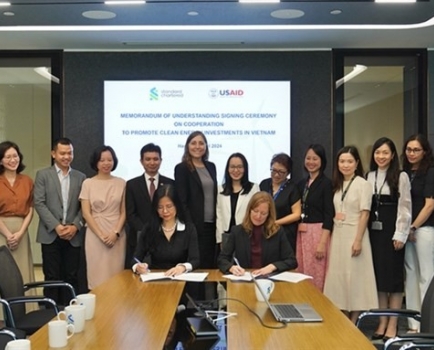Reverse migration from southern industrial hubs a journey to recuperate
Wed, 20 Oct 2021 16:07:00 | Print | Email Share:
For the first time after 13 years working in HCMC, Nguyen Van Bao felt that he was no longer tied to the city.
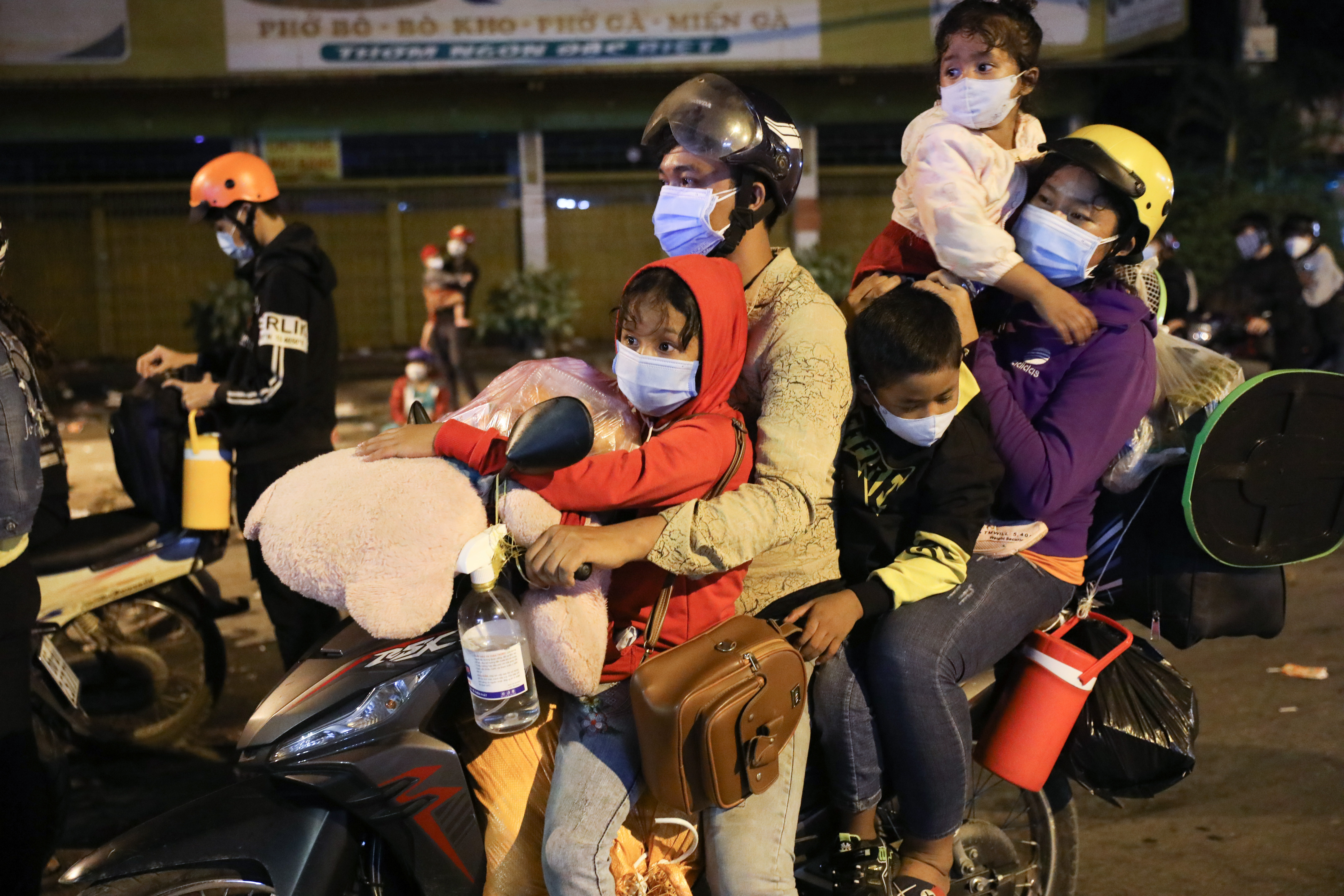
A worker takes his children back to his hometown after Ho Chi Minh City and southern
provinces relax social distancing measures. Photo by VnExpress/Quynh Tran
He finished packing a few old clothes, urged his wife and daughter to get on the motorbike and returned to his hometown of Kien Giang.
Earlier Bao, who rented a house in Ho Chi Minh City's Hoc Mon District, finally received the government Covid-19 relief aid of VND3 million ($129.3).
He used the money to pay his rent for the past few months. Though the landlord had reduced the rent by 70 percent for the three months because of the epidemic, Bao still needed the relief money to pay.
It was the only allowance he received for being unemployed since his previous job was seasonal and not covered by social insurance.
The shoe factory where Bao and his wife worked still has no plans to reopen.
He had decided that the trip home this time will be for good since his wife was about to give birth and their daughter was about to enter first grade.
Having left home for HCMC when he was 18, this was the first time in 13 years he did not feel he had any ties with the city.
Tran Van Dung, 36, too left home in the central province of Quang Binh to earn a living in Dong Nai Province near HCMC, but has now run out of money.
Though Dong Nai has started relaxing its Covid-19 restrictions, due to their fear of the epidemic, he and his family decided to make the thousand-kilometer trip home.
He has been a motorbike-taxi driver for nearly a decade, and his wife was a garment worker. The couple had earned around VND10 million a month, enough for them to live reasonably well.
Watching his two children in raincoats and playing with each other next to his mud-covered motorbike packed with bags and sacks, he could only sigh.
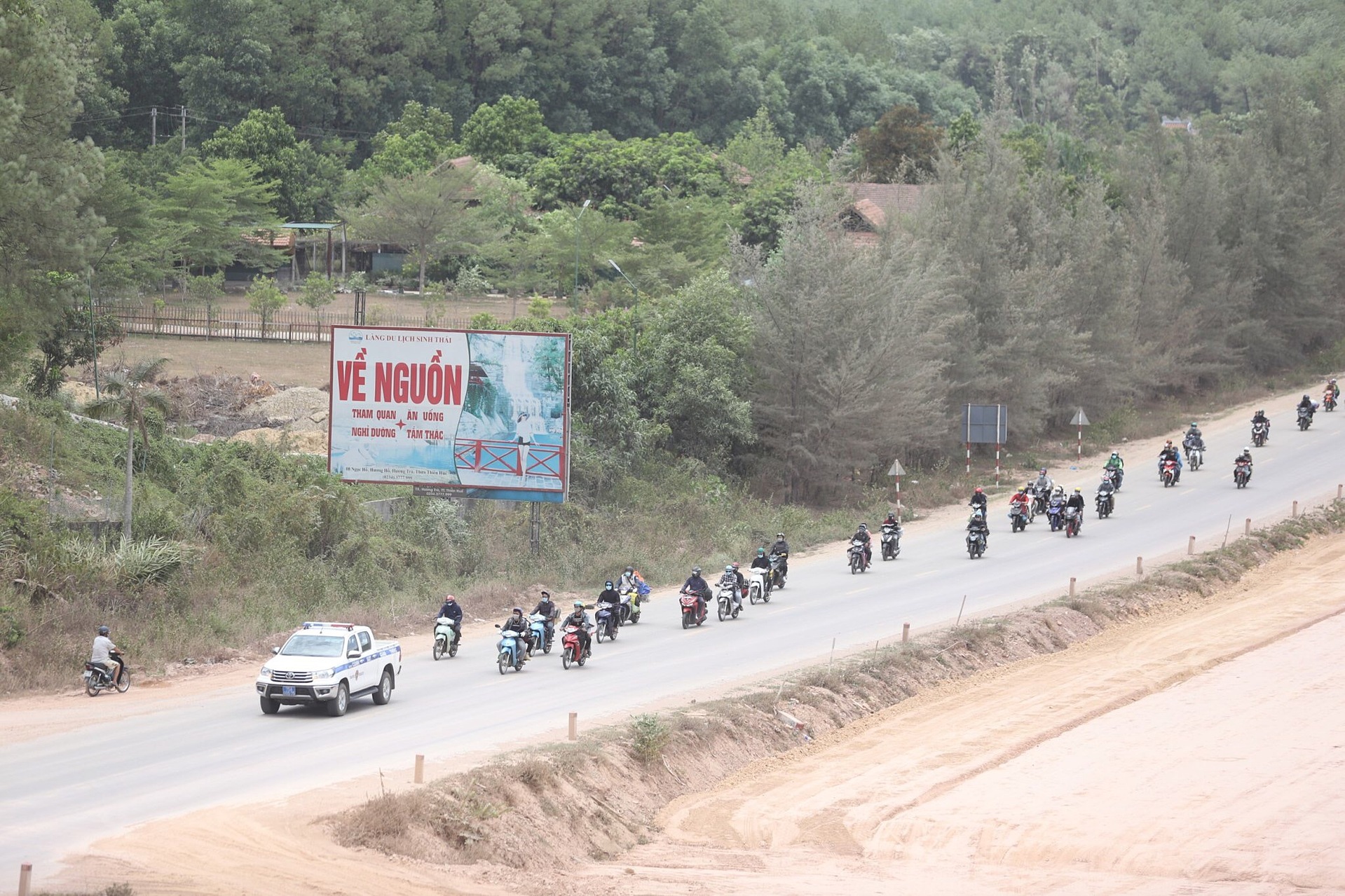
Motorbike drivers passing by Thua Thien Hue Province on their way back to
their hometown in August 2021. Photo by VnExpress/Vo Thanh
Giang A Pao, 25, a Hmong man from near the northern border, also decided to leave the southern Binh Duong Province with his wife Ly Thi Giong to return home.
"You cannot understand the feelings of a husband and wife eating only two packs of instant noodles daily. We had to eat to survive but never fell full at all".
The memory of over 60 days amid the epidemic made him "just want to cry".
The couple had come to Binh Duong in May after having little success finding work in the northern Bac Ninh Province. An electronics company there was only looking for women workers and on a seasonal basis, and so only Giong got a job.
But the couple wanted to work together and so went back home to Lao Cai empty-handed.
And even their decision to become factory workers was due to the pandemic, according to Pao. Covid-19 had caused the trails and paths where he worked as a hired laborer across the border to be closed down. This, coupled with a fear of being infected, forced Pao to stay at home.
Binh Duong was in fact the last option for him to make money so his child could go to school and the family could build a house.
"At home we won't starve, but we won't have money".
But in Binh Duong he only managed to earn "VND20 million twice," enough to buy a motorbike for work and send some money home for his parents to buy fertilizers and corn seeds before the epidemic broke out.
At first Pao and his wife decided to stay back for two weeks to see how it would turn out, but the two weeks ended up turning into two or three months.
On the night of October 5 Pao, his wife and nearly 300 H’mong people from Lao Cai and Son La provinces were at the checkpoint on Trung Ha Bridge in Phu Tho Province after a three-day motorbike trip through nearly 2,000 kilometers.
The men with sunburned faces and bloodshot eyes from rain and dust lay down on the roadside to take short naps before having to resume their police-escorted trip home.
The people had brought with them whatever they could, from coat hangers to a broom to sweep the roadside and a mat they could use to rest.
Who are they?
The families of Bao, Dung and Pao are among tens of thousands of workers who have been returning home by whatever means possible, motorbike, bicycle and even on foot, since the southern localities started lifting their restrictions in early October.
According to local authorities' calculations, 26,000, 40,000, 50,000, and nearly 20,000 people had made their way to the Mekong Delta provinces of Dong Thap, An Giang, Soc Trang, and Ca Mau as of October 6.
The numbers as of October 10 were 40,000 for the Mekong Delta province of Kien Giang, and 87,000 and 40,000 for Nghe An and Hue in the central region.
As for the northern mountain provinces, 2,000, 2,500, 600, and 300 returned to Ha Giang, Son La, Lao Cai, and Lai Chau.

Earlier, between July and September 15, some 1.3 million migrant workers had already returned to their hometowns, according to data released by the General Statistics Office.
These numbers might not be complete, especially for workers in the informal sector, who often do not find a way into official statistics.
Ho Chi Minh City had an estimated three million temporary residents.
A 2015 Oxfam report on migrant workers pointed out that the majority of people migrating to the cities are unskilled or low-skilled workers who could only get simple jobs in the informal sector such as construction workers.
Those entering the formal sector are mostly workers at footwear or textile factories in industrial parks.
The latter accounted for most of the people who made the recent exodus from the city.
According to studies done by Associate Professor Dr Nguyen Duc Loc of the Social Life Research Institute (Social Life) and colleagues of migrant workers working in industrial parks in HCMC, migrant workers are often young and mostly completed secondary or high school. The average age of migrant workers was 26.4 in HCMC and 18-27 in Binh Duong.
In HCMC, more than half the workers are from the Mekong Delta provinces (Vinh Long, Ben Tre, Tien Giang, Dong Thap), and a third are from the north-central and central coasts (Thanh Hoa, Quang Ngai, Binh Dinh, Binh Thuan, Nghe An).
The rates are similar for Binh Duong, with the latest migration survey finding 44.8 percent of migrants were from the delta and 29.6 percent from the north-central and central coasts.
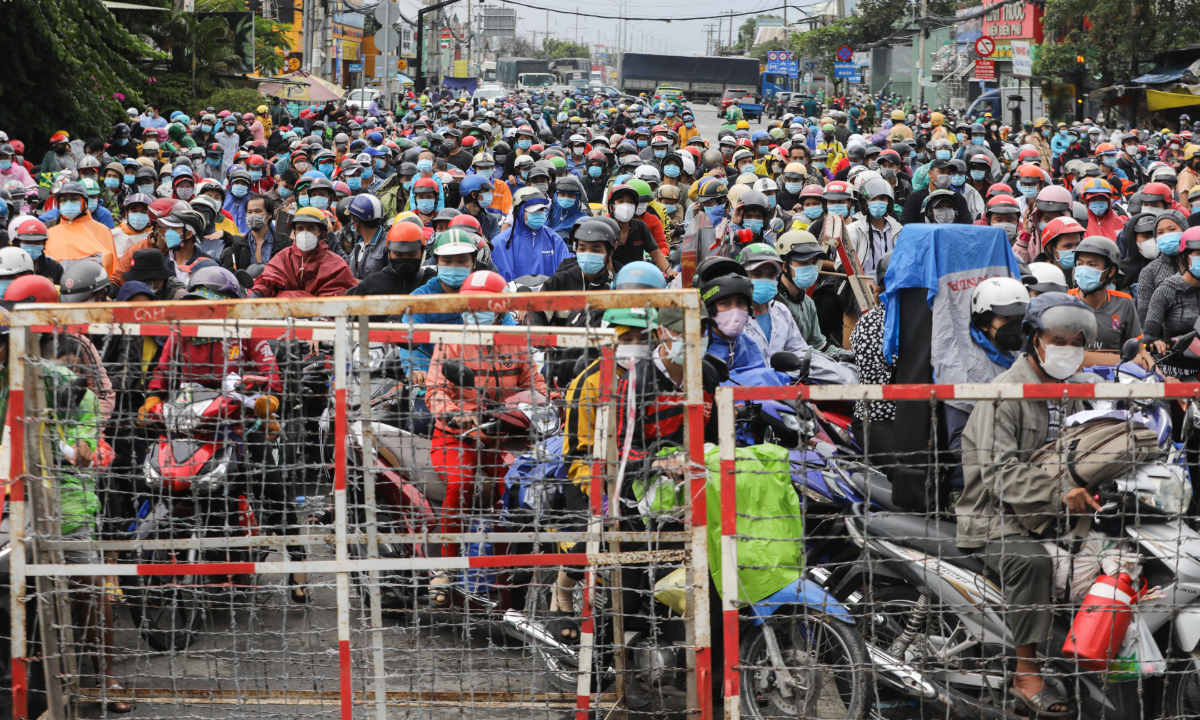
Workers leave Ho Chi Minh City, October 1, 2021.
Photo by VnExpress/Quynh Tran
Do Quynh Chi, director of the Research Center for Employment Relations, said the first mass departure by migrant workers due to Covid was in July just before HCMC and Mekong Delta provinces started implementing lockdowns.
The city had ordered restaurants to close, and many people from the delta, who worked in restaurants, returned home.
She said the second mass departure, which began on October 1, was mainly by factory workers. Surveys she did at over 250 factories and 300 workers in the textile and footwear industries found that 60 percent of migrants had returned to their hometowns or wanted to.
"They are relatively young workers, aged under 40 years, with financial pressures and family burdens such as having young children or ... elderly parents at home."
They were exhausted mentally, physically and economically during the lockdown, and badly wanted to return home, she said.
Covid had turned the southern provinces, which have always been considered good places to make a living, into harh places, further encouraging struggling workers to "go home," she said.
A survey of 457 laborers in Binh Duong and HCMC by Social Life in June-July found that 30 percent of them had lost their jobs or had wages unpaid or delayed.
The institute also cited an estimate based on the General Statistics Office's data from 2017 that under normal circumstances and with no epidemic, the average poor household could only save around VND7 million a year, enough to last them two or three months if thrifty.
An online survey done by VnExpress and the government's Private Economic Development Research Board in August of over 69,000 workers, mostly from the southern region, found that 62 percent of them had lost their jobs due to the pandemic.
Their general lack of savings meant after losing their jobs half only had enough money for living expenses for one month.
Of the rest, 37 percent and 8.6 percent claimed to have enough money to survive for three and six months, and 4.4 percent had enough for over six months.
Pao and his wife had moved into the factory to live as mandated by the authorities. But within 10 days a worker was found to have Covid and they had to return to their rooms and self-quarantine.
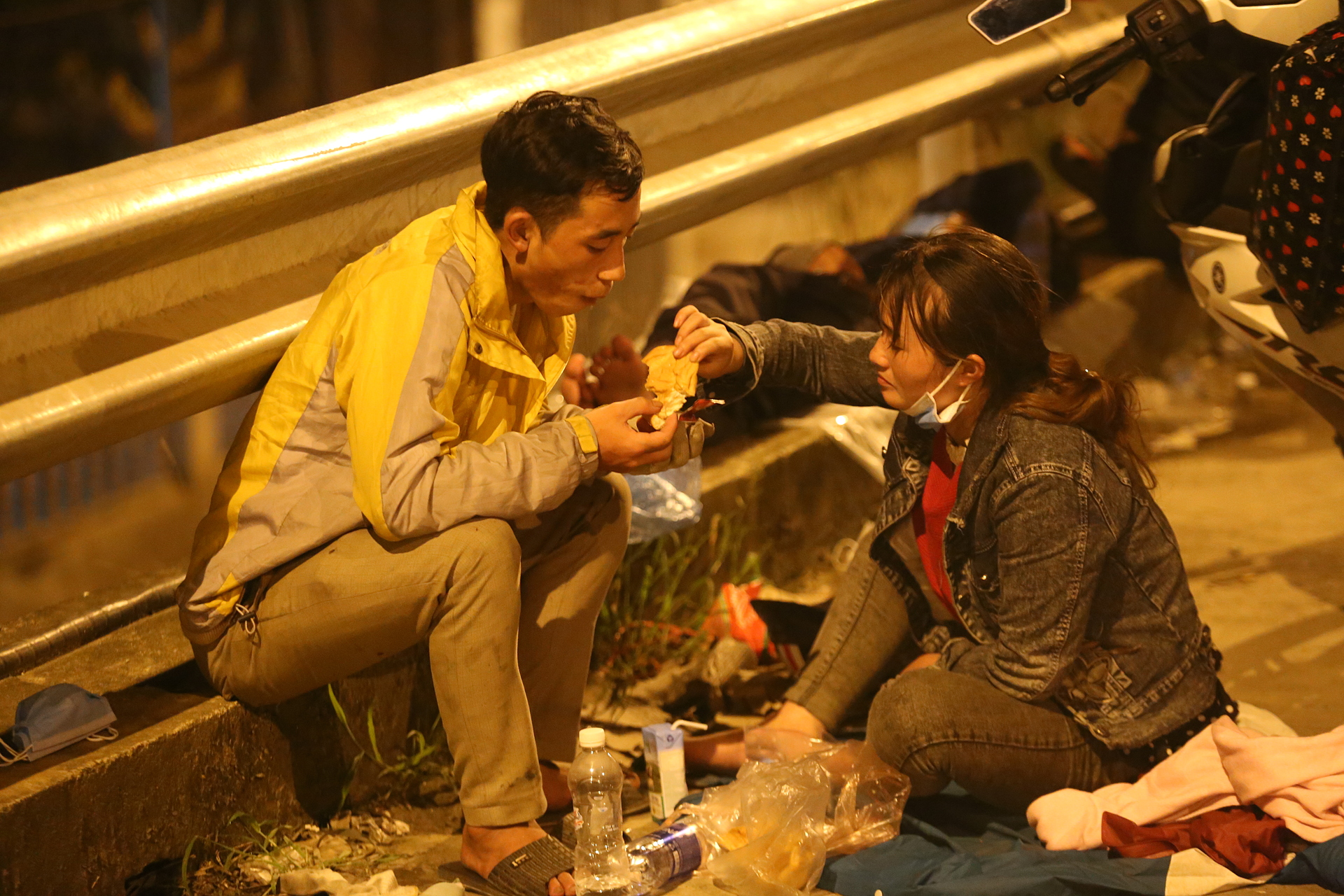
Giang A Pao and his wife share a meal on their way back to their hometown.
Photo by VnExpress/Gia Chinh
The couple received VND800,000 each from the government, enough only to pay the rent and water bill. Since their room was just next to the road, Pao occasionally got a few kilograms of rice or packs of instant noodles from kind donors.
"We ate whatever they gave without asking for anything," he said.
Back in their hometown, they might not have money but would not starve either. "If we have vegetables we eat vegetables, if we have salt we eat salt. As long as the family is not sick, we are happy".
Threat of labor shortage
The return of workers en masse to their hometowns has caused businesses to start worrying about a looming labor shortage.
"Many of the people that left for their hometowns are textile, footwear workers," Truong Van Cam, vice chairman of the Vietnam Textile and Apparel Association, said.
"Once again, the supply chains of these two industries are at risk of being broken."
Nguyen Duy Minh, general secretary of the Vietnam Logistics Association, said workers in Binh Duong who went back home mostly worked for small businesses.
"Those working for large factories in industrial parks are protected by labor contracts, and so a majority of them stayed".
Businesses with good leadership looked after both workers staying on-site and those that did not come for work.
"However, I think there are not many factories that well organized".
The service sector is also facing the problem of labor shortage.
The owner of a large restaurant in HCMC expressed concern that restaurants could face a shortage of workers since many had left for their hometowns.
"If it is just people to carry plates and serve tables, then it is easy; we can find them anywhere. But for skilled positions like chefs and kitchen assistants it is difficult [to find workers].
"Many have decided to stay in their hometowns instead of returning to the city due to fear of the pandemic".
This has made it very difficult for his restaurant to reopen too.
Nhac Phan Linh of the Institute for Workers and Trade Unions, which is run by the Vietnam General Confederation of Labor, said when he spoke to migrant workers traveling from the south, many said they quit their jobs for fear of being infected, especially when living on-site, which also created too much pressure.
Many who were moving back north with their families also said they did not want to return to work in the south, he said.
Instead, they wanted to look for work right in their hometown so that they could settle down and look after their families easier, he added.
Rest and recovery
Chi viewed the mass departure by workers as merely the start of a period of rest for them after becoming too tired in the city.
The results of her surveys also showed that 89 percent of migrant workers and 96 percent of local workers want to return to their old jobs.
However, if they do not get any support from their employers for returning, they expect to take three to five months to recover and go back to work.
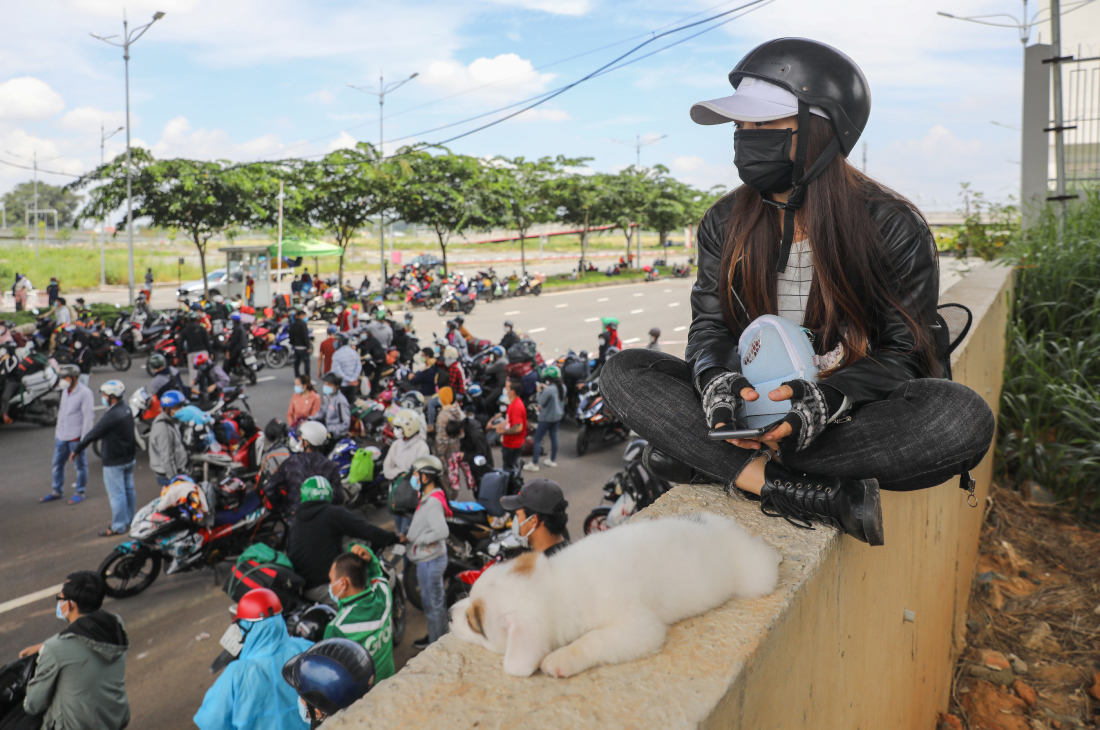
Workers leaving Ho Chi Minh City in August 2021.
Photo by VnExpress/Quynh Tran
Loc compared workers returning to their hometowns with releasing the valve on a pressure cooker. He thought their decision to stay or leave was not made hastily but with careful thought.
"They have Zalo and Facebook groups to exchange information with each other".
Many studies have shown that migrant workers have a major sense of community and regionalism, and they tend to gather, work and live with their compatriots.
"More than 90 percent of migrant workers said they would return to work, which shows that their attachment to the city is very high," Loc said.
HCMC and Binh Duong have become like second homes for many of them, he opined.
Therefore, if local authorities take the initiative to help migrant workers go home now, it could help them recuperate and return with energy when production activities return to normal, he said.
"Do not give workers the impression that the city is a place of harshness and disease without any way to escape.
"Only if they are upset by this impression will they reconsider where to make a living".
Minh said the problem of labor shortage is something for businesses to worry about only in future since they are still operating at below 50 percent capacity and need time to gradually recover.
"The labor problem will be a problem in the next three to six months since they have been able to retain their workers, especially businesses with good management".
Dung and Pao said returning to their hometowns is only temporary and would return once the epidemic is well under control across the country, or "after Lunar New Year" (which falls in next February).
"After Lunar New Year" has become a milestone marking the expected return of many migrant workers. Compared to the fields where he can grow only one rice or corn crop at a time and the work across the border which was "wrong," Pao prefers his job at the carpentry in Binh Duong.
"After Lunar New Year, if the epidemic is over then I might come back." Giong, his wife, will definitely accompany him.
By: Hong Chieu, Phuong Anh, Le Tuyet/Vnexpress
Source: https://e.vnexpress.net/news/business/economy/reverse-migration-from-southern-industrial-hubs-a-journey-to-recuperate-4373809.html
---------------------------------------------
Same category News :



